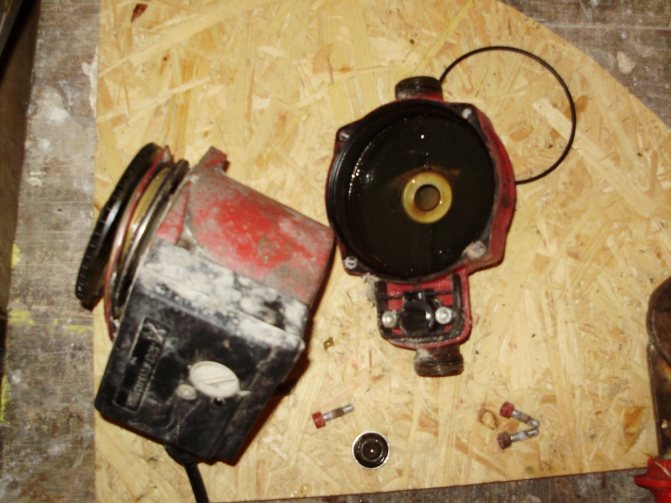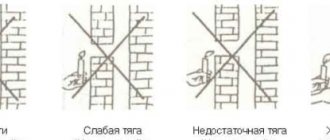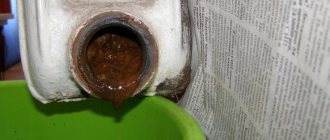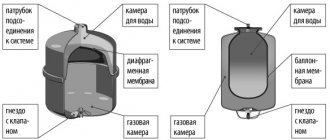The device and principle of operation of the circulation pump
If you do not know what the principle of operation of the circulation pump is, then it will be difficult for you to both make repairs and engage in maintenance.
The circulation pump is constructed from the following elements:
- a body made of stainless steel or non-ferrous alloys;
- an electric motor, the shaft of which is connected to the rotor;
- a rotor on which a wheel with blades is mounted - an impeller (its blades are in constant contact with the pumped medium, they are made of metal or polymer materials).
There are two types of circulating pumps:
- wet rotor;
- with dry rotor.
The types of circulation pumps are described in this article.
For units with a wet rotor, this part is always placed in a liquid medium. These pumps are usually supplied to domestic heating systems. Due to the fact that the rotor is located in the liquid, all moving parts are not only lubricated, but also effectively cooled.
The main advantages of this type of circulation pump:
- During operation, they practically do not emit noise, since the water in which all the parts of the device are located absorbs vibrations well.
- They are simple to install, it is enough to cut them into the pipeline, and repair and maintenance will not take much time and effort.
The disadvantages of pumps with a wet rotor include low capacity, they should be mounted exclusively in a horizontal position. Also, if there is no liquid in the heating system, then such devices may malfunction.

Circulation pump and pump
The drive motor for dry rotor pumps is a separate group. Rotation from the shaft of the electric motor is transmitted to the impeller using a special coupling. Compared with the previous type, this one has a higher performance, the efficiency reaches 80%. Also, the design of units with a dry rotor is more complex, in this regard, it is also somewhat more difficult to maintain and repair.
The most common malfunctions, their causes and remedies
There are situations when the circulation pump for heating does not work. You can fix many of the problems yourself. You can find out faults by a number of characteristics that are distinctive for them.
The circulation pump hums, but the impeller does not rotate
Users often ask the question: why is the heating circulation pump humming and what to do in this situation? Often, pump noise and complete immobility of the impeller occur due to oxidation of the drive motor shaft.
This situation can happen due to the fact that the hydraulic machine has not functioned for a long time. In order to repair the pump with your own hands, you need to follow the sequence of steps:
- initially you must turn off the power supply;
- then it is necessary to drain all the liquid from the pump and the adjacent pipeline;
- after that it is necessary to unscrew the screws and dismantle the drive motor together with the rotor;
- and the last thing you have to do is to move the pump off the dead center, for this you need to rest your hand or a screwdriver against the working notch of the rotor.


Components of the circulation pump
The pump will make noise, but it will not function even if some foreign object gets inside the structure, which will be an obstacle to the rotation of the wheel.Here you need to check the heating circulation pump, find an extra part and resort to repairing the circulation pump:
- the power supply is initially cut off;
- then the water is drained from the pump and pipeline,
- then you need to disassemble the circulation pump as shown in the diagram in the figure;
- then you need to remove the foreign object;
- and at the final stage - a mesh filter is installed on the inlet pipe.
The circulation pump is heating
It is important that the temperature regime of the device is identical to the temperature regime of the coolant pipes. If it has increased, then it means that there were some mistakes in the installation process, or you are simply using it incorrectly. The reasons why the device may warm up are as follows:
- The installation was done incorrectly. It is simple to identify the problem: if the pump heats up immediately after installation, then the reason clearly lies in this.
- Clogged system. During long-term operation, various deposits accumulate in the pipes and rust forms, which makes it difficult for the liquid to pass. Consequently, the pump is overloaded in order to ensure normal circulation of the heating medium. This causes the engine to overheat, but unscheduled maintenance can solve the problem.
- Foreign object. When there is too much slag in the communications from pipes and radiators, pieces of rust or plaque begin to flake off. If they enter the device, the electric motor will jam. If you do not disassemble and clean the device in time, there will be a high probability of a breakdown of the electric motor coil and you will face the problem that the circulation pump for heating will not turn on at all.
- Bearings lack lubrication. When there is not enough lubricant, the bearings begin to wear out very quickly, which negatively affects the service life of the device as a whole.
- Low voltage in the network. At a voltage below 220 V, the electric motor overheats very quickly, which entails a failure.
The switched on pump does not hum and does not work
If the pump is turned on, it does not make any noise, but does not function either, then there may be some problems with the electrical supply. It is important to know how to check the heating circulation pump in this case.
For this, it is not necessary to resort to disassembling the unit. You need to take a tester and check the level and presence of voltage at the terminals of the device. Most often, to solve this problem, it is enough just to make the correct connection of the pump to the power supply.
If there is a fuse in the design of the circulating pump, then it could simply burn out during the transfer of voltage to the electrical network.
In order to start the pump, it is necessary to replace the blown fuse.


Circulation pump power supply diagram
How to repair a heating circulation pump if it turns off by itself
If you are faced with a situation when a layer of lime deposits has appeared on the inner walls of the device and a functioning pump is periodically turned off, then you need to urgently solve this problem.
You need to disassemble the device and clean all of its internal parts. The procedure should be carried out as soon as possible. Delay is fraught with the final failure of the circulation pump.
Why does the heating circulation pump make noise?


Bleeding circulation pump
Often, a lot of noise occurs due to too much air in the pipeline. In order to solve the problem, you need to know how to bleed air from the heating circulation pump.
To solve this problem once and for all, you can install a special unit in the upper section of the heating system circuit, which will independently produce air from the pipeline.
Knocking noise in the heating circulation pump or strong vibration
Most likely the problem is bearing wear. All you have to do is replace this part.


Circulation pump bearing
The main causes of pump overheating
Under ideal conditions, the temperature of the coolant in the hot water supply system should be exactly the same as in the pump. Overheating of the pumping equipment can occur for the following reasons:
- Incorrect installation of the appliance. In this case, the pump overheats at the start of operation.
- The presence of blockages in the circuit. Here, the unit works in an intensive mode in order to push the coolant through the narrow holes, which leads to an increase in pressure and heating of the rotor. The way out of this situation will be to flush the heating system under pressure.
- The ingress of a foreign body under the impeller can be diagnosed by extraneous unpleasant noises or wedging, engine overheating. In this case, it is necessary to disassemble the pump and remove a piece of scale or rust.
- Another reason for overheating is considered to be voltage drops in the network. The device must be taken for diagnostics.
The reasons for the overheating of the unit can be very diverse, but do not rush to remove the device from the pipeline or replace it. First flush out the heating with caustic soda solution. If this does not help, leave a request on the website to call the master or call
How to disassemble a heating circulation pump with your own hands
In order to repair the circulation pump, it is necessary to dismantle it and disassemble it properly.
Initially, the device must be disconnected from the electrical network. To disconnect the cable from the terminal box, it is necessary to remove the case from the power supply unit of the device. Then you need to shut off the water supply by means of the side valves and drain the remainder in the system. Next, the pump must be unscrewed with a hex screwdriver.
You may run into a problem when the bolts are stuck. They need to be moistened with WD-40 liquid and after 20-30 minutes try to unscrew again.
After dismantling is completed, it is necessary to remove the cover of the device. Under it is a rotor with a wheel and blades. You need to remove the rotor, which is usually secured with bolts. This gives you easy access to the internal parts of the pump. Then you should carefully inspect the device and troubleshoot.
Summing up all of the above, it is worth noting once again that the circulation pump is a very important element of the heating system, which is entrusted with serious functions. That is why it is very important to monitor its work and carry out regular maintenance. In case of malfunctions and malfunctions, you need to immediately take the necessary measures, otherwise you can start and your unit will simply fail.
Noise in heating radiators


Heating radiator repair
To identify why heating radiators make noise, you must first check their condition. Often the reason for this is their breakdown - damage to the case or other obvious design defect. In this case, a battery replacement or restoration work is performed.
If everything is normal with the appearance and integrity, the type of noise is determined. Most often, the effect occurs in the form of clicks or constant hum. This can be explained by several factors:
- The appearance of a small airlock... It only slightly hinders the movement of hot water, but at the same time there is a hum in the system;
- A large number of foreign elements in the heating device... This is a common reason why radiators make noise;
- Malfunctions of the thermostat... The check stem has shifted resulting in unwanted noise defects;
- Incorrect battery installation... Vibration during the flow of the heating medium is transmitted to the mounting units in the wall.
These are the main causes of noise in radiators. After correct diagnosis, you can start to work to reduce the sound effects.
In a centralized heating system, only a management company can fix a noisy riser. To do this, you must draw up a statement and hand it over to representatives.


Mayevsky crane design
The elimination of the airlock can be done using the installed Mayevsky crane. It is designed specifically for this purpose.
With the noise of the heating batteries, the autonomous heat supply should be stopped so that the water temperature drops to + 25-30 ° C. Then you should do the following:
- Open Mayevsky's tap.
- Fill the heating system with water gradually.
- Wait until coolant flows from the tap pipe. It should be weaved for 1.5-2 minutes so that the air lock is completely removed.
Then the system is fully started up and checked to see if the noise has appeared in the heating radiators again. If the cause has been identified correctly, this effect will no longer occur.


Debris concentration in the radiator
To eliminate noise in the radiator due to a large amount of debris, the condition of the strainer is first checked. The presence of foreign elements in it (the remains of rusting pipes and radiators, limescale) indicates a clogged system.
Having found out the cause of the noise in the radiators, the system should be cleaned. To do this, you can use several ways:
- Hydrodynamic... Garbage and limescale are removed from the mains and batteries under the action of a strong pressure of water;
- Chemical... Special reagents decompose the clog into small fractions, which are then flushed out of the heating system.
In this way, noise can be eliminated.
Before choosing a cleaning technology, in particular a chemical one, it is necessary to read the instructions for using the composition or method. In some cases, they can adversely affect the integrity of system components.
It is easiest to diagnose the appearance of noise in heating radiators due to improper installation. Its source is fasteners installed in the walls. In this case, it is necessary to replace them and re-install them.
The noise in heating radiators can be caused not only by the problem in them. In some cases, the reason is the malfunctioning of other system components - boilers or pumps. Experts recommend a comprehensive approach to solving the issue of noise in heating radiators. Only a complete diagnosis will help determine the true cause.

























